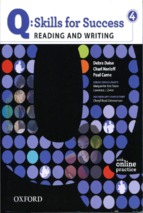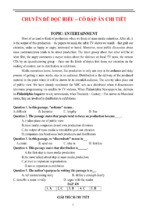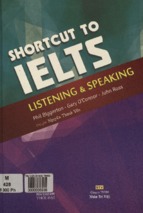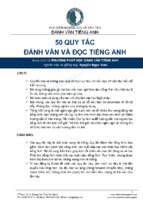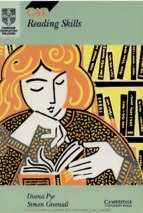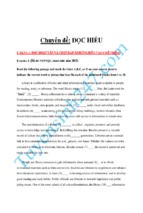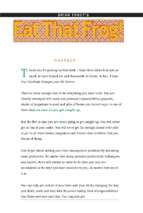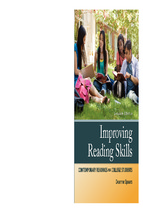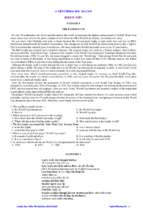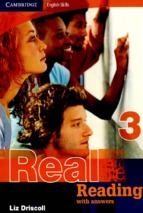Ielts reading multiple choice questions chuyên đề
IELTS Reading Multiple Choice Questions
This type of question follows the order of the text. So when you have found one answer, you
know that the next one will be below, and probably not too far away.
When you start looking at the questions, you should underline key words in the question stem to
help you find the answers in the text.
Look at the IELTS reading multiple choice questions again - as you will see, key words have
been highlighted. You can use these to help you scan the text to find the answers more quickly.
Objectives:
To practice IELTS multiple choice questions
To practice scanning techniques
To look at the use of synonyms in IELTS reading questions
Steps:
Try following these steps when doing multiple choice questions:
1. Read the question and underline the "keywords" - these are the words that you will try
to find in the passage (the main words that give the meaning of the question).
2. Read the choices and underline one or two keywords for each one. Focus on words that
make the difference between each choice.
3. Go to the passage and look for the keywords from the question.
4. When you have found the right part of the passage, look for keywords from the choices.
5. Read the relevant part of the passage carefully, comparing it to each choice.
6. To be sure you have the right answer, you should be able to show that the other answer
choices are wrong.
Tips:
This type of question follows the order of the text. So when you have found one answer, you
know that the next one will be below, and probably not too far away.
When you start looking at the questions, you should underline key words in the question stem to
help you find the answers in the text.
Look at the IELTS reading multiple choice questions again – as you will see, key words have
been highlighted. You can use these to help you scan the text to find the answers more quickly.
Reading in detail
When you read the text for the first time, you should focus on the topic sentences, and skim the
rest of the paragraph.
But once you start answering the IELTS reading multiple choice questions and you have found
where the answer is, you will need to read the text carefully in order to identify the correct
choice.
- Do not think that just because you have found some words in the multiple choices (a, b or c)
that match the words in the text that this must be the right answer.
It’s usually not that simple so you must read the section where you think the answer is carefully.
Example 1:
Different people read for different reasons. For example, the attraction of reading detective
fiction can be in the intellectual challenge of finding out who did it, in an autobiography we
can eavesdrop on the conversations of the great and good or we can laugh at folly in the
celebrity magazine. For many children it is a magic gateway to some other world. Sadly, that
is one of the greatest mistakes they can make.
According to the author, the attraction of reading for young people is:
A. they find out about other countries
B. different from other generations
C. escaping into another world
D. foolish
Without the words highlighted in bold, the answer must be 3., with those words it becomes 4.
Tip: don’t stop reading too soon. An answer may seem right but if the next word is something
like “but” the meaning changes completely
The traps and how to avoid them
It helps to know how the examiners try and trap you. The way they do this is fairly predictable.
Let’s look at another example:
What were the findings of the research in Scotland:
1. anti-smoking legislation was more effective in the USA
2. advertising of tobacco products had less effect on old than on young people
3. the legislation was unpopular with the print media
4. almost a third of young people stopped smoking after the legislation
These conclusions are the result of extensive research carried out over the past 20 years
around various countries into the effect of banning tobacco advertising. In Scotland it was
found that the incidence of smoking fell by 30% in the 18-24 age group after legislation
prohibiting the advertising of tobacco products in all print media was introduced. A separate
piece of research in the United States of America found that when tobacco advertising was
banned in 34 states, this reduced the level of smoking by 50%.
1. Factually true and in the text but doesn’t answer the question
Answer 1 above is wrong because it doesn’t answer the question. This was not the findings of
the research in Scotland It’s easy to fall for this trap as the information is correct.
Tip: always go back and re-read the question before you answer
2. Probably true but you’re guessing information
Answer 2 is wrong because we don’t have the information in the text. We might be able to
guess that this is true, but if it doesn’t say so in the text the answer is not correct.
Tip: always make sure you look at all answers, don’t guess too soon. You may find a better
answer later
3. You’re word matching – read the context
This one contains most words from the text so there is an obvious temptation to say “yes”.
There is in fact no evidence for this in the text at all. A very typical mistake is to match words
in the question and text. You need to read the context for meaning to avoid this mistake.
Tip: always refocus on the exact wording of the question before giving the answer. Be
suspicious of answers that contain almost the same language as the text
Example:
NOW FOR THE BAD NEWS: A TEENAGE TIME BOMB
Para. 1
They are just four, five and six years old right now, but already they are making criminologists
nervous. They are growing up, too frequently, in abusive or broken homes, with little adult
supervision and few positive role models. Left to themselves, they spend much of their time
hanging out on the streets or soaking up violent TV shows. By the year 2005 they will be
teenagers – a group that tends to be, in the view of Notheastern University criminologist James
Alan Fox, “temporary sociopaths – impulsive and immature”. If they also have easy access to
guns and drugs, they can be extremely dangerous.
Para. 2
For all the heartening news offered by recent crime statistics, there is an ominous flip side.
While the crime rate is dropping for adults, it is soaring for teens. Between 1990 and 1994, the
rate at which adults age 25 and older committed homicides declined 22%; yet the rate jumped
16% for youths between 14 and 17, the age group that in early ‘90s supplanted 18- to 24-yearolds as the most crime-prone. And that is precisely the age group that will be blooming in the
next decade. There are currently 39 million children under 10 in the U.S., more than at any time
since the 1950s. “This is the calm before the crime storm,” says Fox. “So long as we fool
ourselves in thinking that we are winning the war against crime, we may be blindsided by this
bloodbath of teenage violence that is lurking in the future”.
Para. 3
Demographics don’t have to be destiny, but other social trends do little to contradict the dire
predictions. Nearly all the factors that contribute to youth crime – single-parent households, child
abuse, deteriorating inner-city schools – are getting worse. At the same time, government is
becoming less, not more, interested in spending money to help break the cycle of poverty and
crime. All of which has led John J. DiIulio JR., a professor of politics and public affairs at
Princeton, to warn about a new generation of “superpredators”, youngsters who are coming of
age in actual and “moral poverty”, without “the benefit of parents, teachers, coaches and clergy
to teach them right or wrong and show them unconditional love”.
Para. 4
Predicting a generation’s future crime patterns is, of course, risky, especially when outside
factors (Will crack use be up or down? Will gun laws be tightened?) remain unpredictable.
Michael Tonry, a professor of law and public policy at the University of Minnesota, argues that
the demographic doomsayers are unduly alarmist. “There will be a slightly larger number of
people relative to the overall population who are at high risk for doing bad things, so that’s going
to have some effect.” Norval Morris, professor of law and criminology at the University of
Chicago, finds DiIulio’s notion of superpredators too simplistic: “The human animal in young
males is quite a violent animal all over the world. The people who put forth the theory of moral
poverty lack a sense of history and comparative criminology.”
Para. 5
Yet other students of the inner city are more pessimistic. “all the basic elements that spawn
teenage crime are still in place, and in many cases the indicators are worse,” says Jonathan
Kozol, author of Amazing Grace, an examination of poverty in the South Bronx. “There is a
dramatic increase of children in foster care, and that’s a very high-risk group of kids. We’re not
creating new jobs, and we’re not improving education to suit poor people for the jobs that exist.”
Para. 6
Can anything defuse the demographic time bomb? For urges “reinvesting in children”:
improving schools, creating after-school programs and providing other alternatives to gangs and
drugs. DiIulio, a law-and-order conservative, advocates tougher prosecution and wants to
strengthen religious institutions to instill better values. Yet the opposes the Gingrichled effort to
make deep cuts in social programs. “A failure to maintain existing welfare and health
commitment for kids,” he says, “is to guarantee that the next wave of juvenile predators will be
even worse than we’re dealing with today.” DiIulio urges fellow conservatives to think of
Medicaid not as a health-care program but as “an anticrime policy”.
(Source: Time Magazine)
1. Young children are making criminologists nervous because
A. they are committing too much crime.
B. they are impulsive and immature.
C. they may grow up to be criminals.
2. The general crime rate in the US is
A. increasing
B. decreasing
C. not changing
3. The age group which commits the highest rate of crime is
A. 14 - 17.
B. 18 - 24.
C. 24 +.
4. James Fox believes that the improvement in crime figures could
A. make us complacent in the fight against crime.
B. result in an increase in teenage violence.
C. result in a decrease in teenage violence.
5. According to paragraph 3, the government
A. is doing everything it can to solve the problem.
B. is not interested in solving the problem.
C. is not doing enough to solve the problem.
6. In comparison with James Fox, Michael Tonry is
A. more pessimistic.
B. less pessimistic.
C. equally pessimistic.
7. Jonathan Kozol believes that
A. there is no solution to the problem.
B. employment and education are not the answer.
C. employment and education can improve the situation.
8. Professor DiIulio thinks that spending on social programs
A. should continue as it is
B. should be decreased.
C. is irrelevant to crime rates.
Key and explainations
(1) Young children are making criminologists nervous because
By the year 2005 they will be teenagers--a group that tends to be, in the view of Northeastern
University criminologist James Alan Fox, "temporary sociopaths--impulsive and immature." If
they also have easy access to guns and drugs, they can be extremely dangerous.(para. 1)
'Children' are not committing more crime so (a) is not correct.
You may have been tempted to tick (b) because the reading mentions " impulsive and immature",
but this is in reference to when they will be teenagers later in life, not the children.
(c) is correct because, as per the quote above, the concern is that when they become teenagers
(grown up) they will commit these crimes.
________________________________________________
(2) The general crime rate in the US is
For all the heartening news offered by recent crime statistics...(para. 2)
"Heartening news" means 'good news' - so the general crime rate is obviously falling as this
would be good news. So the answer is (b)
________________________________________________
(3) The age group which commits the highest rate of crime is
...14 and 17, the age group that in the early '90s supplanted 18- to 24-year-olds as the most
crime-prone.(para. 2)
This tells us the 14-17 age group replaced ('supplanted') 18-24-year-olds as the most likely
('prone') to commit crime, so the answer for this IELTS reading multiple choice question is (a).
________________________________________________
(4) James Fox believes that the improvement in crime figures could
"So long as we fool ourselves in thinking that we're winning the war against crime, we may be
blindsided by this bloodbath of teenage violence that is lurking in the future." (para.2)
Here James is saying that because general crime figures are falling, we may not notice what is
going to happen in the future with teenage crime, so the IELTS reading multiple choice answer is
(a).
It is not logical that falling crime rates could increase or decrease teenage crime (there is no
connection) so it can't be (b) or (c).
________________________________________________
(5) According to paragraph 3, the government
At the same time, government is becoming less, not more, interested in spending money to help
break the cycle of poverty and crime. (para.3)
You have to be careful with this one. Like the IELTS reading multiple choice question 1 you may
be tempted to pick (b) because it mentions 'the government' and has the words 'less interested'
which matches the question.
But is says the government is 'less interested in spending money'. You cannot assume (guess)
from this that the government is 'not interested in solving the problem'. It may just want to
commit more money elsewhere, but this does not mean it has no interest in solving the issue.
So the answer is in fact (c) - the government is not doing enough.
________________________________________________
(6) In comparison with James Fox, Michael Tonry is
Michael Tonry, a professor of law and public policy at the University of Minnesota, argues that
the demographicdoomsayers are unduly alarmist...."it's not going to be an apocalyptic
effect." (para.4)
Here Michael is saying that those who are concerned about the problem (like James) are
worrying too much ("unduly alarmist") and there will not be the terrible consequences
("apocalyptic") like they claim.
So he is obviously less pessimistic and the answer is (b).
________________________________________________
(7) Jonathan Kozol believes that
We're not creating new jobs, and we're not improving education to suit poor people for the jobs
that exist."(para.5)
In this paragraph, Jonathan makes lots of negative points and finishes by saying jobs are not
being created and education not improved. He is therefore citing these as a cause of the problems
he mentioned.
It thus follows that changing this would improve the situation, so the answer is (c).
________________________________________________
(8) Professor DiIulio thinks that spending on social programs
"A failure to maintain existing welfare and health commitment for kids," he says, "is to
guarantee that the next wave of juvenile predators will be even worse than we're dealing with
today." (para.6)
If you don't 'maintain' something, then you don't keep it working as it is. So he is saying that if
spending on welfare and health (social programs) is not kept as it is, things will get worse.
So the answer is (a)
PRACTICE
BASIC LEVEL
Reading passage 1:
VOLUNTEERING: ENRICHING OTHERS AND HELPING ONESELF
A Volunteering, some might mistakenly think, embraces a plethora of people from all walks of
life as well as activities , but data from the other side of the world suggest otherwise. A 2001
survey on who participated in volunteering by the Office for National Statistics (ONS) in the
United Kingdom (UK) revealed that people in higher income households are more likely than
others to volunteer. In England and Wales, 57 per cent of adults with gross annual household
incomes of £75,000 or more, have volunteered formally (such as raising or handling money for a
charity or being a member of a committee) in the 12 months prior to the survey date. They were
almost twice as likely to have done so than those living in households with annual income under
£10,000.
В As well as having high household incomes, volunteers also tend to have higher academic
qualifications, be in higher socio-economic group and be in employment. Among people with a
degree or postgraduate qualification, 79 per cent had volunteered informally and 57 per cent had
volunteered formally in the previous 12 months. For people with no qualifications the
corresponding proportions were 52 per cent and 23 per cent. But voluntary work is certainly not
the exclusive preserve of the rich, nor should it be. Does the answer not lie perhaps in the fact
that the rich tend to have money to allow them the time to become involved in voluntary work
compared to less well-off people?
С A breakdown in the year 2000 of the range of volunteering activities taken from the Australian
Bureau of Statistics given an idea of the scale of activities in which people are typically
involved. Eleven sectors are given ranging from Community and Welfare, which accounted for
just over a quarter of the total hours volunteered in Australia, to Law/justice/politics with 1.2
percent at the other end of scale. Other fields included sport/recreation, religious activities and
education, following at 21.2 per cent, 16.9 and 14.3 per cent respectively. Foreign/international
volunteer work accounted for 2.4 per cent of the total hours. The data here also seem to point to a
cohort of volunteers with experience.
D The knock-on effect of volunteering on the lives of individuals can be profound. Voluntary
work helps foster independence and imparts the ability to deal with different situations, often
simultaneously, thus teaching people how to work their way through different systems. It
therefore brings people into touch with the real world; and, hence, equips them for the future.
E Initially, young adults in their late teens might not seem to have the expertise or knowledge to
impart to others that say a teacher or agriculturalist or nurse would have, but they do have many
skills that can help others. And in the absence of any particular talent, their energy and
enthusiasm can be harnessed for the benefit of their fellow human beings, and ultimately
themselves. From all this, the gain to any community no matter how many volunteers are
involved is immeasurable.
F Employers will generally look favourably on people who have shown ability to work as part of
a team. It demonstrates a willingness to learn and an independent spirit, which would be
desirable qualities in any employee. So to satisfy employers’ demands for experience when
applying for work, volunteering can act as a means of gaining experience that might otherwise
elude would-be workers and can ultimately lead to paid employment in the desired field.
G But what are the prerequisites for becoming a volunteer? One might immediately think of
attributes like kindness, selflessness, strength of character, ability to deal with others,
determination, adaptability and flexibility and a capacity to comprehend the ways of other
people. While offering oneself selflessly, working as a volunteer makes further demands on the
individual. It requires a strength of will, a sense of moral responsibility for one’s fellow human
beings, and an ability to fit into the ethos of an organization or community. But it also requires
something which in no way detracts from the valuable work done by volunteers and which may
seem at first glance both contradictory and surprising: self-interest.
H Organizations involved in any voluntary work have to be realistic about this. If someone,
whatever the age, is going to volunteer and devote their time without money, they do need to
receive something from it for themselves. People who are unemployed can use volunteer work as
a stepping-stone to employment or as a means of finding out whether they really like the field
they plan to enter or as a way to help them find themselves.
I It is tempting to use some form of community work as an alternative to national service or as
punishment for petty criminals by making the latter for example clean up parks, wash away
graffiti, work with victims of their own or other people. This may be acceptable, but it does not
constitute volunteer work, two cardinal rules of which are the willingness to volunteer without
coercion and working unpaid.
1. The ONS survey was done to find out
A why people undertook volunteering.
B how many people participated in volunteering.
C how many rich people did volunteer work.
D which people were involved in volunteering.
2. The ONS survey found that people with university qualifications were
A as likely to volunteer as those with no qualifications.
B more likely to volunteer than those with no qualifications.
C less likely to volunteer than those with no qualifications.
D the only group likely to do formal volunteer work.
3. It is suggested that rich people volunteer as a result of having
A clearer goals.
B fewer children.
C more spare time.
D greater guilt.
4. Volunteer work benefits people by teaching them how to
A function in systems.
B communicate clearly.
C deal with failure.
D overcome shyness.
Reading passage 2:
A NEUROSCIENTIST REVEALS HOW TO THINK DIFFERENTLY
In the last decade a revolution has occurred in the way that scientists think about the brain. We now know
that the decisions humans make can be traced to the firing patterns of neurons in specific parts of the brain.
These discoveries have led to the field known as neuroeconomics, which studies the brains secrets to
success in an economic environment that demands innovation and being able to do things differently from
competitors. A brain that can do this is an iconoclastic one. Briefly, an iconociost is a person who does
something that others say can't he done.
This definition implies that iconoclasts are different from other people, but more precisely, it is their brains
that are different in three distinct ways: perception, fear response, and social intelligence. Each of these
three functions utilizes a different circuit in the brain. Naysayers might suggest that the brain is irrelevant,
that thinking in an original, even revolutionary. way is more a matter of personality than brain function. But
the held of neuroeconomics was born out of the realization that the physical workings of the brain place
limitations on the way we make decisions. By understanding these constraints, we begin to understand why
some people march to a different drumbeat.
The first thing to realize is that the brain suffers from limited resources. It has a fixed energy budget, about
the same as a 40 watt light bulb, so it has evolved to work as efficiently as possible. This is where most
people are impeded from being an iconoclast. For example, when confronted with information streaming
from the eyes, the brain will interpret this information in the quickest way possible. Thus it will draw on
both past experience and any other source of information, such as what other people say, to make sense of
what it is seeing. This happens all the time. The brain takes shortcuts that work so well we are hardly ever
aware of them. We think our perceptions of the world are real, but they are only biological and electrical
rumblings. Perception is not simply a product of what your eyes or ears transmit to your brain. More than
the physical reality of photons or sound waves, perception ls a product of the brain.
Perception is central to iconoclasm. Iconoclasts see things differently to other people. Their brains do not
fall into efficiency pitfalls as much as the average person’s brain. iconoclasts, either because they were born
that way or through learning, have found ways to work around the perceptual shortcuts that plague most
people. Perception ls not something that is hardwired into the brain. It is a learned process, which is both a
curse and an opportunity for change. The brain faces the fundamental problem of interpreting physical
stimuli from the senses.
Everything the brain sees, hears, or touches has multiple interpretations. The one that is
ultimately chosen is simply the brain's best theory. ln technical terms, these conjectures have
their basis in the statistical likelihood of one interpretation over another and are heavily
influenced by past experience and, importantly for potential iconoclasts what other people say.
The best way to see things differently to other people is to bombard the brain with things it has
never encountered before. Novelty releases the perceptual process from the chains of past
experience and forces the brain to make new judgments. Successful iconoclasts have an
extraordinary willingness to be exposed to what is fresh and different. Observation of iconoclasts
shows that they embrace novelty while most people avoid things that are different.
The problem with novelty, however, is that lt tends to trigger the brain's fear system. Fear is a
major impediment to thinking like an iconoclast and stops the average person in his tracks. There
are many types of fear, but the two that inhibit iconoclastic thinking and people generally find
difficult to deal with are fear of uncertainty and fear of public ridicule. These may seem like
trivial phobias. But fear ol public speaking, which everyone must do from time to time, afflicts
one third of the population. This makes it too common to be considered a mental disorder. It is
simply a common variant of human nature, one which iconoclasts do not let inhibit their
reactions
Finally, to be successful iconoclasts, individuals must sell their ideas to other people. This is
where social intelligence comes in. Social intelligence is the ability to understand and manage
people in a business setting. ln the last decade there has been an explosion of knowledge about
the social brain and how the braln works when groups coordinate decision making. Neuroscience
has revealed which brain circuits are responsible for functions like understanding what other
people think, empathy, fairness, and social identity. These brain regions play key roles in whether
people convince others of their ideas. Perception is important in social cognition too. The
perception of someone's enthusiasm, or reputation, can make or break a deal. Understanding how
perception becomes intertwined with social decision making shows why successful iconoclasts
are so rare.
Iconoclasts create new opportunities in every area from artistic expression to technology to
business They supply creativity and innovation not easily accomplished by committees. Rules
aren't important to them. Iconoclasts face alienation and failure, but can also be a major asset to
any organization. It is crucial for success in any field to understand how the iconoclastic mind
works.
5. Neuroeconomics is a field of study which seeks to
A. cause a change in how scientists understand brain chemistry.
B. understand how good decisions are made in the brain.
C .understand how the brain is linked to achievement in competitive fields.
D. trace the specific firing patterns of neurons in different areas of the brain.
6. According to the writer, iconoclasts are distinctive because
A. they create unusual brain circuits.
B. their brains function differently.
C. their personalities are distinctive.
D. they make decisions easily.
7. According to the writer, the brain works efficiently because
A. it uses the eyes quickly.
B. it interprets data logically.
C. it generates its own energy.
D. it relies on previous events.
8. The writer says that perception is
A. a combination of photons and sound waves.
B. a reliable product of what your senses transmit.
C. a result of brain processes.
D. a process we are usually conscious of.
9. According to the writer an iconoclastic thinker
A. centralizes perceptual thinking in one part of the brain.
B. avoids cognitive traps.
C. has a brain that is hardwired for learning.
D. has more opportunities than the average person.
Reading passage 3:
THE DEVELOPMENT OF MUSEUMS
A The conviction that historical relics provide infallible testimony about the past is rooted in the
nineteenth and early twentieth centuries, when science was regarded as objective and value free.
As one writer observes: 'Although it is now evident that artifacts are as easily altered as
chronicles, public faith in their veracity endures: a tangible relic seems ipso facto real! Such
conviction was, until recently, reflected in museum displays. Museums used to look — and some
still do — much like storage rooms of objects packed together in showcases: good for scholars
who wanted to study the subtle differences in design, but not for the ordinary visitor. to whom lt
all looked alike. Similarly, the information accompanying the objects often made little sense to
the lay visitor. The content and format of explanations dated back to a time when the museum
was the exclusive domain of the scientific researcher.
B Recently, however, attitudes towards history and the way lt should be presented have altered.
The key word in heritage display is now 'experience the more exciting the better and, if possible,
involving all the senses. Good examples of this approach ln the UK are the Jorvik Centre in
York; the National Museum of Photography, Elm and Television in Bradford; and the imperial
War Museum in London. In the US the trend emerged much earlier. Williamsburg has been a
prototype for many heritage developments in other parts of the world. No one can predict where
the process will end. On so called heritage sites the re-enactment of historical events is
increasingly popular, and computers will soon provide virtual reality experiences, which will
present visitors with a vivid image of the period of their choice, in which they themselves can act
as if part of the historical environment. Such developments have been criticised as an intolerable
vulgarisation. but the success of many historical theme parks and similar locations suggests that
the majority of the public does not
share this opinion.
C In a related development, the sharp distinction between museum and heritage sites on the one
hand, and theme parks on the other. is gradually evaporating. They already borrow ideas and
concepts from one another. For example, museums have adopted storylines for exhibitions, sites
have accepted 'theming’ as a relevant tool, and theme parks are moving towards more
authenticity and research-based presentations in zoos, animals are no longer kept in cages, but in
great spaces, either ln the open air or in enormous greenhouses, such as the jungle and desert
environments .In Burgers' Zoo In Holland. This particular trend is regarded as one of the major
developments in the presentation of natural history in the twentieth century.
D Theme parks are undergoing other changes, too, as they try to present more serious social and
cultural issues, and move away from fantasy. This development is a response to market forces
and, although museums and heritage sites have a special. rather distinct, role to fullfil, they are
also operating in a very competitive environment, where visitors make choices on how and
where to spend their free time. Heritage and museum experts do not have to invent stories and
recreate historical environments to attract their visitors: their assets are already in place.
However, exhibits must be both based on artefacts and facts as we know them, and attractively
presented. Those who are professionally engaged in the art of interpreting history are thus ln a
difficult position, as they must steer a narrow course between the demands of ’evidence' and
‘attractiveness especially given the increasing need in the heritage industry for income
generating activities.
E It could be claimed that in order to make everything in heritage more `real` historical accuracy
must be increasingly altered. For example, Pithecanthropus erectus is depicted in an Indonesian
museum with Malay facial features, because this corresponds to public perceptions. Similarly, in
the Museum of Natural History in Washington, Neanderthal man is shown making a dominant
gesture to his wife. Such presentations tell us more about contemporary perceptions of the world
than about our ancestors. There is one compensation, however, for the professionals who make
these interpretations: If they did not provide the interpretation, visitors would do it for
themselves. based on their own ideas. misconceptions and prejudices. And no matter how
exciting the result, it would contain a lot more bias than the presentations provided by experts.
F Human bias is inevitable, but another source of bias in the representation of history has to do
with the transitory nature of the materials themselves. The simple fact is that not everything from
history survives the historical process. Castles, palaces and cathedrals have a longer lifespan than
the dwellings of ordinary people. The same applies to the famishing and other contents of the
premises. In a town like Leyden in Holland, which in the seventeenth century was occupied by
approximately the same number of inhabitants as today, people lived within the walled town, an
area more than five times smaller than modern Leyden. In most of the houses several families
lived together in circumstances beyond our imagination. Yet In museums, line period rooms give
only an image of the lifestyle of the upper class of that era. No wonder that people who stroll
around exhibitions are filled with nostalgia; the evidence in museums indicates that life was so
much better in the past. This notion is induced by the bias in its representation in museums and
heritage centers.
10. Compared with today's museums those of the past
A did not present history in a detailed way.
B were not primarily intended for the public.
C were more clearly organized.
D preserved items with greater care.
11. According to the writer, current trends in the heritage industry
A emphasize personal involvement.
B have their origins in York and London,
C rely on computer images.
D reflect minority tastes.
12. The writer says that museums. heritage sites and theme parks
A often work in close partnership.
B try to preserve separate identities.
C have similar exhibits.
D are less easy to distinguish than before.
13. The writer says that in preparing exhibits for museums, experts
A should pursue a single objective.
B have to do a certain amount of language translation.
C should be free from commercial constraints.
D have to balance conflicting priorities.
14. In paragraph E. the writer suggests that some museum exhibits
A fall to match visitor expectations.
B are based on the false assumptions of professionals.
C reveal more about present beliefs than about the past.
D allow visitors to make more use of their imagination.
15. The passage ends by noting that our view of history is biased because
A we fail to use our imagination.
B only very durable objects remain from the past.
C we tend to ignore things that displease us.
D museum exhibits focus too much on the local area.
Reading passage 4:
THE PSYCHOLOGY OF INNOVATION
Why are so few companies truly innovative?
Innovation is key to business survival ,and companies put substantial resources into inspiring
employees to develop new ideas. There are, nevertheless, people working in luxurious, state-ofthe-art centres designed to stimulate innovation who find that their environment doesn’t make
them feel at all creative. And there are those who don’t have a budget, or much space, but who
innovate successfully.
For Robert B. Cialdini, Professor of Psychology at Arizona State University, one reason that
companies don’t succeed as often as they should is that innovation starts with recruitment.
Research shows that the fit between an employee’s values and a company’s values makes a
difference to what contribution they make and whether, two years after they join, they’re still at
the company. Studies at Harvard Business School show that, although some individuals may be
more creative than others, almost every individual can be creative in the right circumstances.
One of the most famous photographs in the story of rock’n’roll emphasises Ciaidini’s views. The
1956 picture of singers Elvis Presley, Carl Perkins, Johnny Cash and Jerry Lee Lewis jamming at
a piano in Sun Studios in Memphis tells a hidden story. Sun’s ‘million-dollar quartet’ could have
been a quintet. Missing from the picture is Roy Orbison’ a greater natural singer than Lewis,
Perkins or Cash. Sam Phillips, who owned Sun, wanted to revolutionise popular music with
songs that fused black and white music, and country and blues. Presley, Cash, Perkins and Lewis
instinctively understood Phillips’s ambition and believed in it. Orbison wasn’t inspired by the
goal, and only ever achieved one hit with the Sun label.
The value fit matters, says Cialdini, because innovation is, in part, a process of change, and
under that pressure we, as a species, behave differently, ‘When things change, we are hard-wired
to play it safe.’ Managers should therefore adopt an approach that appears counterintuitive -they
should explain what stands to be lost if the company fails to seize a particular opportunity.
Studies show that we invariably take more gambles when threatened with a loss than when
offered a reward.
Managing innovation is a delicate art. It’s easy for a company to be pulled in conflicting
directions as the marketing, product development, and finance departments each get different
feedback from different sets of people. And without a system which ensures collaborative
exchanges within the company, it’s also easy for small ‘pockets of innovation ‟ to disappear.
Innovation is a contact sport. You can‟t brief people just by saying, ‘We’re going in this direction
and I’m going to take you with me.’
Cialdini believes that this ‘follow-the-leader syndrome, is dangerous, not least because it
encourages bosses to go it alone. ‘It’s been scientifically proven that three people will be better
than one at solving problems, even if that one person is the smartest person in the field.’ To prove
his point, Cialdini cites an interview with molecular biologist James Watson. Watson, together
with Francis Crick, discovered the structure of DNA, the genetic information carrier of all living
organisms. ‘When asked how they had cracked the code ahead of an array of highly
accomplished rival investigators, he said something that stunned me. He said ”he and Crick had
succeeded because they were aware that they weren’t the most intelligent of the scientists
pursuing the answer. The smartest scientist was called Rosalind Franklin who, Watson said, “was
so intelligent she rarely sought advice”.’
Teamwork taps into one of the basic drivers of human behaviour. ‘The principle of social proof is
so pervasive that we don’t even recognise it,’ says Cialdini. ‘If your project is being resisted, for
example, by a group of veteran employees, ask another old-timer to speak up for it.’ Cialdini is
not alone in advocating this strategy. Research shows that peer power, used horizontally not
vertically, is much more powerful than any boss’s speech.
Writing, visualising and prototyping can stimulate the flow of new ideas. Cialdini cites scores of
research papers and historical events that prove that even something as simple as writing deepens
every individual’s engagement in the project. It is, he says, the reason why all those competitions
on breakfast cereal packets encouraged us to write in saying, in no more than 10 words: ‘I like
Kellogg’s Com Flakes because… .’ The very act of writing makes us more likely to believe it.
Authority doesn’t have to inhibit innovation but it often does. The wrong kind of leadership will
lead to what Cialdini calls ”captainitis, the regrettable tendency of team members to opt out of
team responsibilities that are properly their’. He calls it captainitis because, he says, ”crew
members of multipilot aircraft exhibit a sometimes deadly passivity when the flight captain
makes a clearly wrong-headed decision”. This behaviour is not, he says, unique to air travel, but
can happen in any workplace where the leader is overbearing.
At the other end of the scale is the 1980s Memphis design collective, a group of young designers
for whom ”the only rule was that there were no rule”. This environment encouraged a free
interchange of ideas, which led to more creativity with form, function, colour and materials that
revolutionised attitudes to furniture design.
Many theorists believe the ideal boss should lead from behind, taking pride in collective
accomplishment and giving credit where it is due. Cialdini says:”Leaders should encourage
everyone to contribute and simultaneously assure all concerned that every recommendation is
important to making the right decision and will be given full attention” The frustrating thing
about innovation is that there are many approaches, but no magic formula. However, a manager
who wants to create a truly innovative culture can make their job a lot easier by recognising
these psychological realities.
16. The example of the ‘million-dollar quartet’ underlines the writer’s point about
A recognising talent.
B working as a team.
C having a shared objective.
D being an effective leader.
17. James Watson suggests that he and Francis Crick won the race to discover the DNA code
because they
A were conscious of their own limitations.
B brought complementary skills to their partnership.
C were determined to outperform their brighter rivals.
D encouraged each other to realise their joint ambition.
18. The writer mentions competitions on breakfast cereal packets as an example of how to
A inspire creative thinking.
B generate concise writing.
C promote loyalty to a group.
D strengthen commitment to an idea.
19. In the last paragraph, the writer suggests that it is important for employees to
A be aware of their company‟s goals.
B feel that their contributions are valued.
C have respect for their co-workers‟ achievements.
D understand why certain management decisions are made.
Reading passage 5:
THE MEANING AND POWER OF SMELL
The sense of smell, or olfaction, is powerful. Odours affect us on a physical, psychological and
social level. For the most part, however, we breathe in the aromas which surround us without
being consciously aware of their importance to us. It is only when the faculty of smell is
impaired for some reason that we begin to realise the essential role the sense of smell plays in
our sense of well-being.
A A survey conducted by Anthony Synott at Montreal's Concordia University asked participants
to comment on how important smell was to them in their lives. It became apparent that smell can
evoke strong emotional responses. A scent associated with a good experience can bring a rush of
joy, while a foul odour or one associated with a bad memory may make us grimace with disgust.
Respondents to the survey noted that many of their olfactory likes and dislikes were based on
emotional associations. Such associations can be powerful enough so that odours that we would
generally label unpleasant become agreeable, and those that we would generally consider
fragrant become disagreeable for particular individuals. The perception of smell, therefore,
consists not only of the sensation of the odours themselves, but of the experiences and emotions
associated with them.
B Odours are also essential cues in social bonding. One respondent to the survey believed that
there is no true emotional bonding without touching and smelling a loved one. In fact, infants
recognise the odours of their mothers soon after birth and adults can often identify their children
or spouses by scent. In one well-known test, women and men were able to distinguish by smell
alone clothing worn by their marriage partners from similar clothing worn by other people. Most
of the subjects would probably never have given much thought to odour as a cue for identifying
family members before being involved in the test, but as the experiment revealed, even when not
consciously considered, smells register.
C In spite of its importance to our emotional and sensory lives, smell is probably the most
undervalued sense in many cultures. The reason often given for the low regard in which smell is
held is that, in comparison with its importance among animals, the human sense of smell is
feeble and undeveloped. While it is true that the olfactory powers of humans are nothing like as
fine as those possessed by certain animals, they are still remarkably acute. Our noses are able to
recognise thousands of smells, and to perceive odours which are present only in extremely small
quantities.
D Smell, however, is a highly elusive phenomenon. Odours, unlike colours, for instance, cannot
- Xem thêm -




